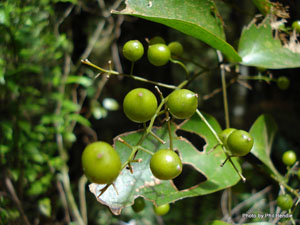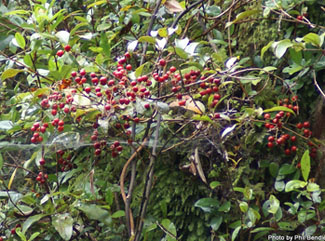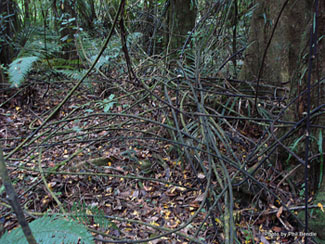





To support our efforts please browse our store (books with health benefits, etc.).
Supplejack vine is in the botanical family of Ripogonaceae, a family found only in New Zealand, eastern Australia and New Guinea. It is a hardy, evergreen climber. Early Maori used the tough stems of the Supplejack vine to tie the thatches roofs and walls of their homes. These were used to tie up fencing and platforms as well. Both the Maori and European settlers used this hardy vine to make crayfish pots, eel traps, ladders, flooring platforms in canoes, and baskets. As well as being used in construction, this vine is a great source of food and has been used as medicine. Various parts of the vine have been used for bowel troubles, rheumatism, fever, and as a blood tonic.
Distinguishing Features
Supplejack vines climb by coiling; its stems around branches and tree trunks for support. Where there is an absence of support the vines drop to the ground and loop around the forest floor in a very dense entanglement making walking very challenging. In the first year of its life it resembles a small shrub so it isn’t until the second year it begins to take the shape of a vine. In the summer months its tips grow 5 centimetres daily. Once the Supplejack reaches full sunlight it produces non-twining leafy stems that bear flowers and fruits.
Flowers
Individual flowers have six white to pale green or yellow tepals and they are very small. The tepals measure about 2mm long. The flowers are hermaphrodite and the flowers appear from December to February.
 Fields
of Nutrition has medicinal benefits and vitamin/mineral content of Supplejack Vine.
Fields
of Nutrition has medicinal benefits and vitamin/mineral content of Supplejack Vine.
Leaves
The leaves are mostly opposite, green, dark green or yellow-green. They are narrow-ovate to oblong shaped, narrowed rather abruptly to the tip and they tend to undulate.
Height
This vine can grow to several metres in length as it likes to grow toward the sunlight through the forests.
Habitat
Supplejack is a common vine that grows in lowland forests of New Zealand, and in the forests of Zealandia. It prefers light, sandy, loamy, and clay soils that are moist. It tends to grow in semi-shaded woodlands. It can also grow in swampy areas.
Edible Parts
The berries are edible once they are ripe and can be eaten raw or cooked. Very young shoots are palatable and supposedly resemble asparagus in taste; it is best to eat these cooked. The seeds can be consumed and contain fatty acids. The sap can be consumed as well. The roots are known to be a substitute for sarsaparilla and they are rich in starch. Leaves are also edible.
Other Name
Kareao (Maori).
I want to send out a very special thank-you to Phil Bendle in New Zealand. Phil is the webmaster, researcher, and photographer for Te Henui on the website TERRAIN (Taranaki Educational Resource: Research, Analysis and Information Network). Phil has graciously permitted EdibleWildFood.com to use his photos.
Winter Survival Food Handbook

PDF Plant Magazines
Types of Wild Food
Geographic Zones Seasons
Disclaimer
EdibleWildFood.com is informational in nature. While we strive to be 100% accurate, it is solely up to the reader to ensure proper plant identification. Some wild plants are poisonous or can have serious adverse health effects.
We are not health professionals, medical doctors, nor are we nutritionists. It is up to the reader to verify nutritional information and health benefits with qualified professionals for all edible plants listed in this web site. Please click here for more information.
Why Edible Wild Food?
- Food costs are rising
- Free, wild food is readily abundant
- Wild food adds nutrition to your diet
- Wild food can help treat various medical conditions







